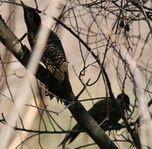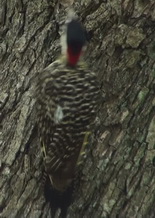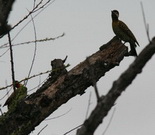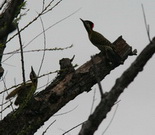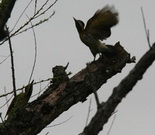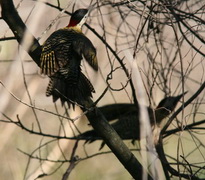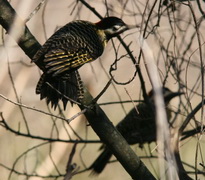Order: Piciformes - Family: Picidae
The Green-barred Woodpecker is a resident bird which breeds in the reserve. It is easy to recognize because of its size and colour, its striking voice, the drumming on the trees and its flight technique: three wingbeats and a glide.
As breeding time comes, the need for food and nesting place intensify the territorial disputes. These cases show only male contendants. Though in the case of the video there was participation of other individuals, their sex remained unknown. It is still to be solved the role they play and whether the female participates somehow.
When woodpeckers confront they exhibit ritualized behaviours, the function of which is to cause the rival to leave without fighting, or behaviours of overt agression. The ritual is ellicited through a very "lively" body language. The agression, through aerial spiraling chases interspersed with pecks and aerial kicks.
The scene of the ritual is the tree. The territory holder takes position in front of the intruder at a prudent distance and begins with the displays. It intimidates the rival moving its bill in a pompous way. With a stretched neck the bill is swung upwards, downwards and sideways as if it were a baton. This threatening posture is known as the Bill-waving Dance. This dance is accompanied by wing movements, body and tail jerks and striking calls, which combined or singly intensify the threat. One common wing movement is to extend both wings over the back and retract them. The tail, instead, is fanned out.
After an initial bout of displays they wait for the reaction and then they begin again. Antagonists do not necessarily follow a sequential dialogue. Sometimes the rival seems unresponsive to the performance, on some other occasions the response is quick and they overlap.
If threats are not effective to solve the conflict, actions will escalate. Pecks, aerial kicks and aerial spiraling chases around trees are added to the beforementioned displays. They leave the static scene of the branch to move around the whole tree and its surroundings. Face to face woodpeckers peck at each other and dodge strikes with agile maneuvers. Face to face they give aerial kicks with the feet while moving the wings forward and backwards to keep afloat. They also chase each other in a spiral around tree trunks and branches.
This encounter lasted four minutes during which there were breaks. Nevertheless, It was clear there was a latent agitation state. The presence of the other two woodpeckers in the surroundings added excitement to the conflict.
The Displacement Pecking was observed on several opportunities during the conflict. Due to the opponent's unresponsiveness the woodpecker pecks at a branch or trunk to resolve the conflict somehow. The Raised Head Feathers display was also observed.
Video December 2009 © Roberto Ares





